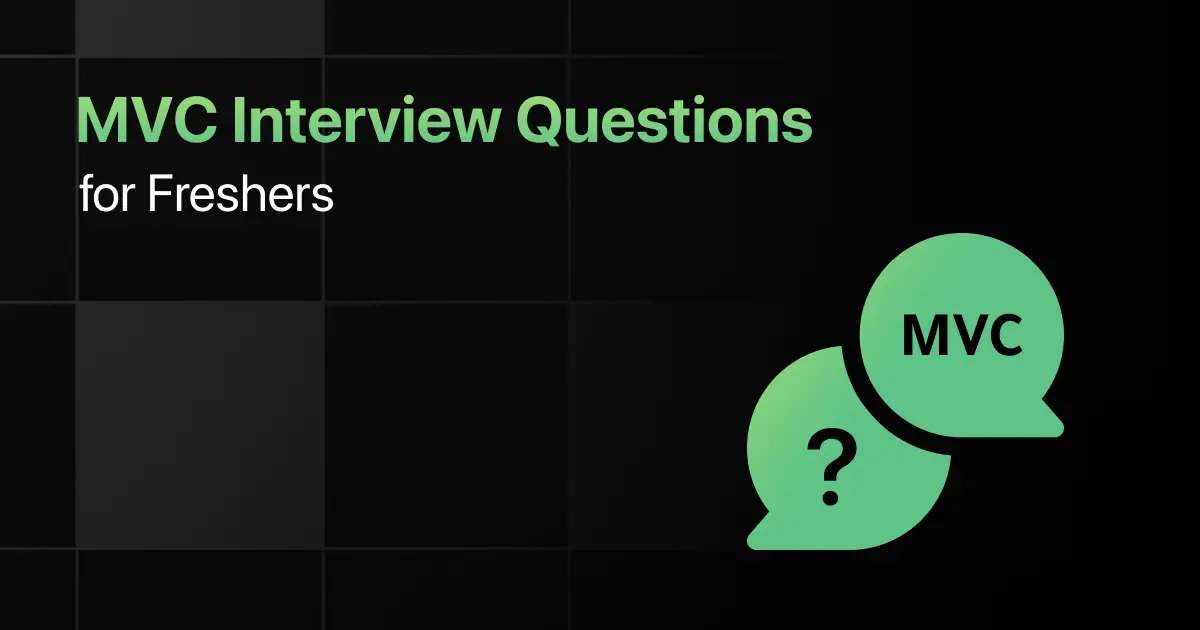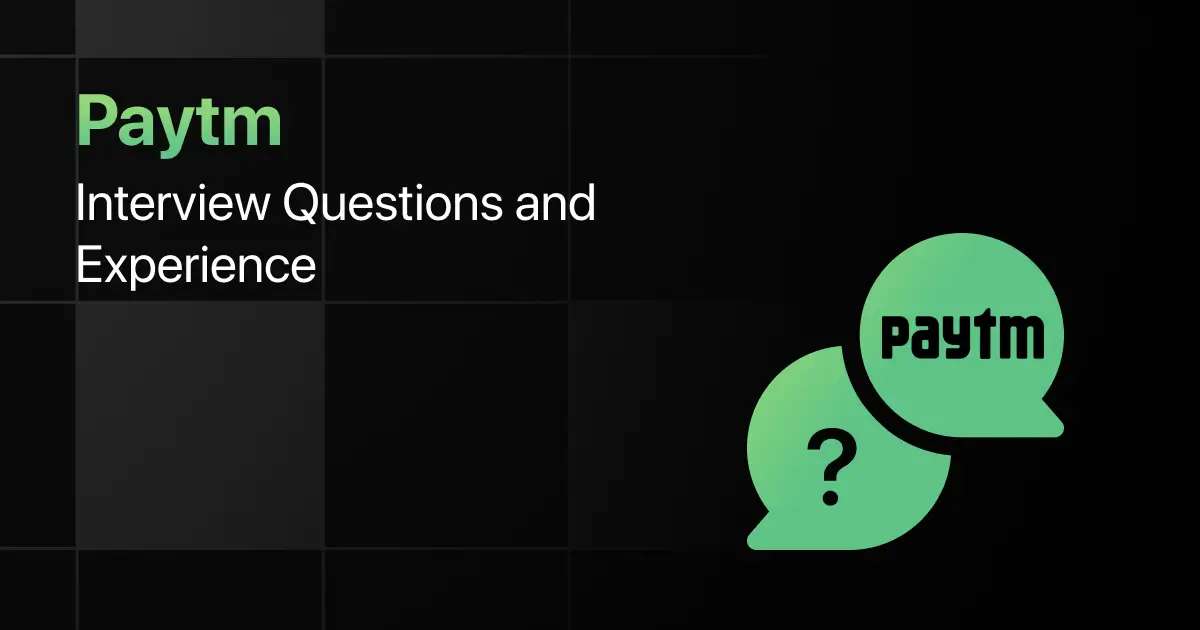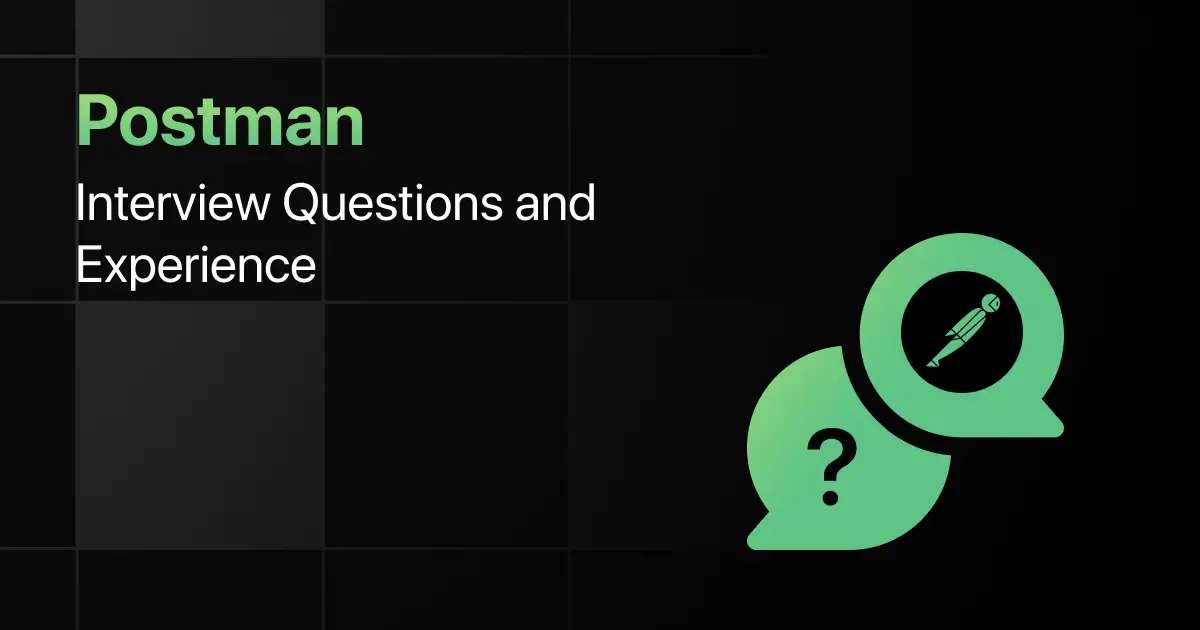Top MVC Interview Questions for Freshers

Are you preparing for your first MVC interview and wondering what questions you might face?
Understanding the key MVC interview questions for freshers can give you more clarity.
With this guide, you’ll be well-prepared to tackle these MVC interview questions and answers for freshers and make a strong impression in your interview.
Practice MVC Interview Questions and Answers
Below are the top 50 MVC interview questions for freshers with answers:
1. What is the MVC pattern?
Answer:
MVC stands for Model-View-Controller. It is a design pattern used for developing user interfaces by dividing an application into three interconnected components. The Model represents the data, the View displays the data, and the Controller manages the logic and user input.
2. What are the main components of the MVC pattern?
Answer:
The three main components of MVC are:
- Model: Handles the data and business logic.
- View: Responsible for presenting data to the user.
- Controller: Manages the communication between the Model and the View and handles user input.
3. How does the Model component function in MVC?
Answer:
The Model in MVC represents the data and the business logic of the application. It retrieves data from a database or any data source and passes it to the Controller. The Model is also responsible for updating the data when necessary.
4. How does the View component function in MVC?
Answer:
The View is responsible for rendering the UI of the application. It receives the data from the Controller and presents it to the user in a formatted way. The View only handles the presentation logic and does not directly interact with the data.
5. How does the Controller component function in MVC?
Answer:
The Controller handles the user input and manipulates the data using the Model. It also sends commands to the Model to update data and to the View to update the UI. The Controller acts as an intermediary between the Model and the View.
6. What are the advantages of using the MVC pattern?
Answer:
MVC promotes a clean separation of concerns. It helps in organizing code into modular sections, which improves maintainability, testability, and scalability. By separating data (Model), UI (View), and logic (Controller), developers can work on different aspects of the application simultaneously.
7. What is the role of the Controller in managing user input?
Answer:
The Controller captures user input from the View and processes it. It then decides how to interact with the Model to fetch or update data, and finally, it determines which View should display the data to the user.
8. What is separation of concerns in MVC?
Answer:
Separation of concerns in MVC refers to the division of responsibilities into distinct components:
- Model: Manages data and business rules.
- View: Deals with the display of data.
- Controller: Handles the logic and user input. This separation makes the application easier to maintain and test.
9. Can you explain the flow of an MVC application?
Answer:
In an MVC application, the flow typically follows these steps:
- The user interacts with the UI (View).
- The Controller handles the input and manipulates the Model.
- The Model updates the data and notifies the Controller.
- The Controller instructs the View to update based on the new data.
10. How does the Controller communicate with the Model and the View?
Answer:
The Controller receives input from the user and communicates with the Model to retrieve or update data. It then selects the appropriate View to display the data. The Controller acts as the link between the Model and the View but ensures that these two components do not directly interact with each other.
11. What is the difference between the MVC pattern and MVVM?
Answer:
In MVC, the Controller handles both user input and view logic. In MVVM (Model-View-ViewModel), the ViewModel replaces the Controller and binds the View directly to the Model through data binding. MVVM is often used in data-driven applications, whereas MVC focuses more on user-driven logic.
12. Why is MVC considered a good architectural pattern for web applications?
Answer:
MVC is highly suitable for web applications because it cleanly separates the user interface (View) from the business logic (Model) and user interactions (Controller). This allows for parallel development, scalability, and ease of testing, which are essential in web development.
13. What is a ViewModel in the context of MVC?
Answer:
A ViewModel is a model specific to the view. It may combine several models or pieces of data into a format required for rendering the view. However, a ViewModel should not contain business logic, which belongs in the Model.
14. Can multiple views share the same model in MVC?
Answer:
Yes, multiple views can share the same model. The same data can be represented differently in various views based on user interaction or business requirements, but all views will work with the same underlying data (Model).
15. What is the main disadvantage of MVC?
Answer:
One of the main disadvantages of MVC is its complexity, especially in large applications. Implementing strict separation of concerns can lead to more code and a steeper learning curve for developers who are new to the pattern.
16. Can the Controller be bypassed in an MVC application?
Answer:
In a well-implemented MVC application, the Controller should not be bypassed. It is essential for handling input and coordinating actions between the Model and the View. Bypassing the Controller may break the separation of concerns and result in a tightly coupled codebase.
17. What is a front controller pattern in MVC?
Answer:
The front controller pattern refers to using a single controller to handle all incoming requests. This controller acts as the main entry point and then dispatches the requests to specific controllers based on the request parameters.
18. Can an MVC model be reused in different applications?
Answer:
Yes, the Model in MVC is typically designed to be reusable across different applications. Since it contains only the business logic and data-handling code, it can be reused in various contexts without modifying the View or Controller.
19. What is the role of data binding in MVC?
Answer:
Data binding in MVC is the process of automatically populating the View with data from the Model. It helps streamline the process of displaying data without having to manually retrieve or format it within the View.
20. What is a tightly coupled system in MVC, and why is it undesirable?
Answer:
A tightly coupled system in MVC occurs when the components (Model, View, and Controller) are heavily dependent on each other. This goes against the principle of separation of concerns, making the system harder to maintain, test, and extend.
21. How is validation typically handled in MVC?
Answer:
Validation is usually handled at the Model level in MVC. The Controller may pass input to the Model, where the business rules and validations are enforced. The results are then returned to the Controller, which can instruct the View to display errors if necessary.
22. What is the Observer pattern’s role in MVC?
Answer:
The Observer pattern is often used in MVC to allow the View to observe changes in the Model. When the Model’s data changes, it notifies the View (observer), which then updates itself accordingly. This decouples the Model from the View and Controller.
23. What is the purpose of a dispatcher in MVC?
Answer:
A dispatcher in MVC is responsible for routing user requests to the appropriate Controller and action. It acts as a mediator, ensuring that each user request is handled by the correct logic in the application.
24. How does MVC promote parallel development?
Answer:
MVC promotes parallel development by allowing developers to work on the Model, View, and Controller independently. For example, front-end developers can work on the View while back-end developers work on the Model, without causing conflicts in the codebase.
25. Can you explain how routing works in an MVC application?
Answer:
In an MVC application, routing is the process of mapping incoming requests (usually URLs) to the appropriate Controller and action. This mapping is typically defined in a routing configuration, where each route is associat
26. What is a Controller’s responsibility in error handling within MVC?
Answer:
The Controller in MVC handles errors by capturing exceptions and then redirecting the user to an appropriate error view or response. It ensures that the user is informed about the problem, often without exposing internal details. The Controller can also log errors for further analysis.
27. What is the difference between View and ViewModel in MVC?
Answer:
In MVC, the View is responsible for presenting data to the user, while the ViewModel is not part of the traditional MVC pattern but often used in variants like MVVM. The ViewModel provides data to the View, structured specifically for UI display, and may aggregate multiple models into a single representation for the View.
28. What is a partial view in MVC?
Answer:
A partial view is a reusable section of the user interface in MVC that can be embedded within other views. It is helpful when you want to reuse common UI components, like navigation bars or footers, across multiple pages. Partial views help in maintaining clean and modular code.
29. How is session management typically handled in MVC?
Answer:
Session management in MVC is handled through the Controller. The Controller can store and retrieve session data as needed. It can also manage cookies, track user sessions, and maintain state information across requests.
30. What are the responsibilities of the Controller in MVC regarding business logic?
Answer:
The Controller in MVC does not handle business logic directly. Instead, it acts as a mediator between the user interface (View) and the business logic (Model). It forwards user requests to the Model, where business rules are applied, and then returns the appropriate response to the View.
31. How is data passed between the View and the Controller in MVC?
Answer:
Data is passed from the Controller to the View via model objects or view data. The Controller fetches data from the Model, processes it if necessary, and then passes it to the View to be rendered. For passing data from View to Controller (e.g., form submission), the Controller collects user input from the View.
32. What is the difference between MVC and MVP patterns?
Answer:
In the MVC pattern, the Controller manages the user input and interacts with both the Model and View. In the MVP (Model-View-Presenter) pattern, the Presenter interacts with the View and Model, but the View is passive, meaning it doesn’t directly invoke methods on the Model.
33. How does unit testing work in an MVC architecture?
Answer:
In MVC, unit tests can be written to verify the functionality of the Model and Controller components. The Model can be tested for its business logic, while the Controller can be tested for correct handling of requests and responses. The View is typically not unit-tested because it deals with presentation.
34. What is the role of filters in MVC?
Answer:
Filters in MVC are used to execute logic before or after a Controller action is executed. They can be used for tasks such as authentication, logging, error handling, or input validation. Filters help centralize cross-cutting concerns, promoting code reuse.
35. What is the Dispatcher pattern, and how is it used in MVC?
Answer:
The Dispatcher pattern in MVC is responsible for managing the navigation between Controllers based on user requests. It directs incoming requests to the appropriate Controller and action method. The Dispatcher decouples the request-handling logic from the Controller, enhancing modularity.
36. What is the difference between MVC and 3-tier architecture?
Answer:
MVC is a design pattern that separates an application into three components: Model, View, and Controller. In contrast, a 3-tier architecture separates an application into three logical layers: presentation, business logic, and data. While MVC is more UI-focused, 3-tier is focused on overall application structure.
37. How does the Observer pattern fit into the MVC design?
Answer:
The Observer pattern is often used between the Model and View in MVC. When the Model’s state changes, it notifies the View, which then updates the user interface accordingly. This decouples the Model from directly interacting with the View, improving modularity and flexibility.
38. Can you explain the role of routing in an MVC application?
Answer:
Routing in MVC is the process of mapping incoming requests (usually URLs) to specific Controllers and their actions. The routing configuration defines how requests are directed to Controllers. For instance, a URL path like /products/list might route to the ProductController’s list action.
39. How can dependency injection be used in MVC?
Answer:
Dependency injection (DI) can be used in MVC to inject dependencies into Controllers, Models, or Services. It allows the Controller to receive its dependencies, such as a service or repository, through constructor or method injection, rather than creating them directly, promoting loose coupling and testability.
40. What is lazy loading, and how is it applied in MVC?
Answer:
Lazy loading is a design pattern where an object or resource is not loaded until it is required. In MVC, this is often applied in Models when fetching data from a database. The data is not fetched until the Controller or View explicitly requests it, reducing the initial loading time.
41. What are the best practices for organizing an MVC project?
Answer:
Some best practices for organizing an MVC project include:
- Keeping Models, Views, and Controllers in separate directories.
- Avoiding business logic in Controllers.
- Using ViewModels or DTOs (Data Transfer Objects) to avoid exposing Models directly in Views.
- Implementing proper routing and URL mapping.
42. What is the role of a Service Layer in an MVC architecture?
Answer:
A Service Layer in MVC acts as an intermediary between the Controller and the Model. It contains business logic and helps in organizing code more efficiently. By using a Service Layer, the Controller can delegate tasks like database access or complex computations, improving maintainability and testability.
43. How can you handle multiple models in a single view in MVC?
Answer:
Handling multiple models in a single view can be achieved using a ViewModel. A ViewModel can contain multiple models or different pieces of data required by the view. The Controller assembles the ViewModel and passes it to the View, which can then access all the data needed.
44. Can MVC be used for desktop applications?
Answer:
Yes, MVC can be used for desktop applications. Although it is more commonly associated with web development, the MVC pattern is also suitable for organizing desktop applications by separating the data (Model), UI (View), and logic (Controller).
45. What is an action method in MVC?
Answer:
An action method is a method in the Controller that handles incoming requests. Each action method corresponds to a specific URL route and returns a response, often in the form of a View. Action methods process data, interact with the Model, and determine what to display to the user.
46. Can you explain client-side MVC vs server-side MVC?
Answer:
In server-side MVC, the server handles the business logic, routing, and rendering of views, often returning fully-rendered HTML to the client. In client-side MVC, the client (typically the browser) handles these tasks, using JavaScript frameworks (like Angular or React) to update the UI dynamically without full page reloads.
47. How does MVC improve testability?
Answer:
MVC improves testability by separating the concerns of the application. The Model can be tested independently of the UI, and the Controller can be tested for correct input handling and logic. Mocking frameworks can be used to test Controllers without needing actual Views or Models.
48. What is the purpose of scaffolding in MVC?
Answer:
Scaffolding in MVC is a technique that automatically generates the code for basic CRUD (Create, Read, Update, Delete) operations. It helps speed up development by generating the necessary Controller actions and Views based on the Model structure.
49. How does two-way data binding work in MVC?
Answer:
Two-way data binding allows data to be synchronized between the Model and the View. Changes in the View automatically update the Model, and changes in the Model automatically update the View. While native MVC doesn’t inherently support this, frameworks like Angular (based on MVC concepts) implement two-way binding.
50. What are some common pitfalls of using MVC?
Answer:
Some common pitfalls of using MVC include:
- Overcomplicating small applications with unnecessary structure.
- Placing too much business logic in the Controller.
- Tight coupling between the Model and Controller, violating separation of concerns.
- Not leveraging reusable Views and partials, leading to code duplication.
Final Words
Getting ready for an interview can feel overwhelming, but going through these MVC fresher interview questions can help you feel more confident.
With the right preparation, you’ll ace your MVC interview but don’t forget to practice MVC architecture, routing, controllers, and Razor views-related interview questions too.
Frequently Asked Questions
1. What are the most common interview questions for MVC?
Common MVC interview questions include topics like the MVC architecture, the role of the controller, routing, model binding, filters, and dependency injection.
2. What are the important MVC topics freshers should focus on for interviews?
Freshers should focus on building small MVC projects, understanding the flow of requests in MVC, and practicing common interview questions involving routing, action methods, and filters.
3. How should freshers prepare for MVC technical interviews?
Freshers should focus on building small MVC projects, understanding the flow of requests in MVC, and practicing common interview questions involving routing, action methods, and filters.
4. What strategies can freshers use to solve MVC coding questions during interviews?
Break down the problem, understand the flow of data between views and controllers, use debugging tools effectively, and focus on separation of concerns in your code.
5. Should freshers prepare for advanced MVC topics in interviews?
Yes, freshers should prepare advanced topics like dependency injection, middleware, and working with authentication/authorization is crucial for MVC interviews.
Explore More Interview Questions
Related Posts


Paytm Interview Questions and Experience
Preparing for a Paytm interview requires a clear understanding of the company’s hiring process, the type of questions asked, and …









